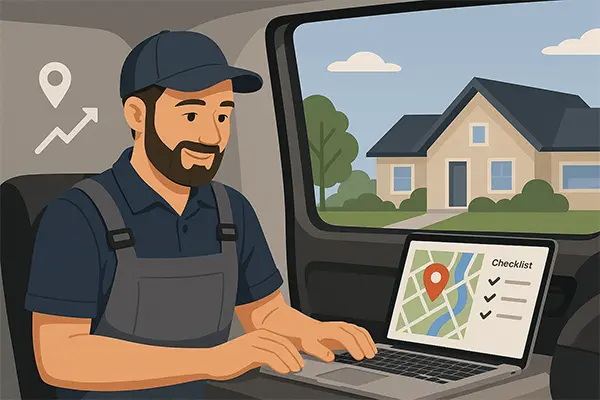
Ever wonder why you’re not showing up in the map pack—even though your Google Business Profile is claimed, your reviews are solid, and your phone’s not exactly ringing off the hook?
Here’s the deal: If your website isn’t doing its part, your local rankings won’t either.
Local SEO doesn’t start out there—it starts right here, on your website.
Let’s break down the on-page SEO basics every contractor and service business owner needs to get right if you want to show up where it counts (and land more local jobs while you're at it).
We’ll keep it simple. Actionable. And no, you don’t need to be a tech wizard to follow along.
Step 1: Your Title Tags and Meta Descriptions Need a Makeover
Think of these as your digital first impression.
They’re the clickable headlines and mini blurbs you see in Google search results.
Bad: “Home | Johnson Electric”
Better: “Licensed Electrician in Rochester NY | Johnson Electric”
Use your service + location. Keep it snappy. Add a benefit when you can.
🚨 Hot Tip: Your meta description won’t boost rankings directly, but a great one gets more clicks—and more clicks tell Google you’re worth showing off.
Step 2: Use Headers Like a Pro (H1s, H2s, H3s...Yeah, Those)
Don’t just throw up a wall of text. Structure it with headings so Google (and real people) can actually follow what you’re saying.
Your H1 should be clear and local:
Example: “Roof Repair Services in Fairport NY”
Then use H2s and H3s to guide people through your page. Add related keywords—stuff like “emergency roof leak” or “licensed contractor in Fairport.”
Not only does this make your content readable, it makes it rankable.
Step 3: Have a Page for Every Location You Serve
If you cover multiple towns, don't jam them all on one page. That’s lazy SEO—and it won’t work anymore.
Instead, give each location its own love.
Example:
-
/webster-deck-repair -
/greece-bathroom-remodeling
Google sees these as dedicated answers for people searching in those exact areas. And when your page answers their local need? You win.
Step 4: Schema = Geeky But Game-Changing
Schema markup is like giving Google a cheat sheet.
When you add LocalBusiness schema to your site, you’re telling search engines:
“Hey, I’m a real business, this is where I’m located, and here’s what I do.”
If you want your business info to show up clean in search results—like stars, hours, service area—schema helps make that happen.
Bonus: At Altered Vision Designs, we bake schema into every site we build. Just sayin’.
Step 5: NAP Isn’t Just for Toddlers
Name. Address. Phone number. That’s your NAP—and it should be:
-
Visible on every page (typically in the footer)
-
Written the same everywhere online (no funny business like “123 Main Street” on your site and “123 Main St.” on your GBP)
-
Actual text—not part of an image
Inconsistent NAP = confused Google = lower rankings. Keep it clean and consistent.
Step 6: Add a Map So Google Knows Where to Find You
Want to show up in local searches? Then show that you’re, well, local.
Add an embedded Google Map to your Contact page.
Even if you’re a service area business without a storefront, you can still pin your HQ or home base.
This helps customers—and search engines—know where you’re coming from.
Step 7: Don’t Forget About Image Alt Text
Every image on your site should help your SEO, not just your design.
Give each one a smart alt tag like:
"Custom kitchen remodel in Irondequoit NY by ABC Contractors"
This tells Google what the image is about (since it can’t actually see), improves accessibility, and boosts your local relevance.
Plus—it’s super easy to do and often overlooked. So go win that edge.
Step 8: Internal Linking = The Secret Weapon
Link your pages to each other. Not only does it help visitors explore your site, it tells Google how your content fits together.
Example:
On your “Furnace Installation” page, link to “Furnace Maintenance” and “Thermostat Upgrades.”
This keeps people engaged and improves rankings. Win-win.
Step 9: Make Your Website Fast, Mobile-Friendly, and Easy to Use
Google is obsessed with user experience.
If your site takes forever to load, looks awful on phones, or buries key info behind confusing menus—kiss those rankings goodbye.
Make sure your site:
-
Loads in under 3 seconds
-
Looks clean and easy on mobile
-
Has clear menus, calls to action, and contact info
Use tools like PageSpeed Insights to test. Then fix what’s broken.
Step 10: Show Off Your Reviews and Trust Signals
Got happy customers? Show them off right on your service pages.
Use review plugins or embed your Google reviews. Even better? Add review schema so those golden stars show up in search results.
And don’t forget trust badges—like licenses, years in business, or “veteran-owned” labels. These build confidence and improve conversion.
Step 11: Tell Visitors What to Do Next (Seriously, Be Obvious)
Don’t assume people will figure it out.
End each page with a strong, clear, localized CTA:
-
“Call now to schedule your AC tune-up in Henrietta”
-
“Get a free estimate for deck repair in Pittsford”
-
“Request a quote today from your local bathroom remodeling experts”
Make it click-worthy. Make it easy. Make it count.
The Final Word: Get Your On-Page SEO Right and Everything Else Gets Easier
You can chase backlinks and reviews all day, but if your website isn’t dialed in, you’re building on a shaky foundation.
That’s why on-page SEO for local businesses is where it all begins.
It’s the difference between being visible and being invisible.
At Altered Vision Designs, we specialize in building SEO-friendly websites for contractors who want more leads and better rankings—without the headache.
Want help turning your site into a lead-generating machine? Let’s chat. We’ll take care of the SEO. You take care of the customers.

